#Christ the King Cathedral
Text

Christ the King Cathedral, Gitega, Burundi
Augustine Tours
0 notes
Text

Cathedral of Christ the King in Reykjavik, Iceland
Icelandic vintage postcard, mailed in 1937 to France
#carte postale#sepia#photo#postkarte#tarjeta#cathedral of christ the king#ansichtskarte#cathedral#icelandic#reykjavik#postkaart#ephemera#postcard#vintage#king#historic#mailed#postal#iceland#christ#briefkaart#1937#france#photography
4 notes
·
View notes
Text

Une chapelle latérale de la cathédrale catholique de Liverpool. D'architecture moderne, bâtie entre 1962 et 1967, elle est moins jolie que la cathédrale anglicane de la ville mais elle est lumineuse, extrêmement propre, et l'on s'y sent bien.
6 notes
·
View notes
Text
Catholic Cathedral Interior. Nikon F65. Expired Truprint 200 (shot at 800.)
Whilst it is possible to see the Anglican Cathedral from the steps of its catholic counterpart the latter is a very different building. Original plans show a building in a more classical style however, only the crypt was built.
The Metropolitan Cathedral of Christ The King was completed in 1969 and is one of the most distinctive structures in the city.


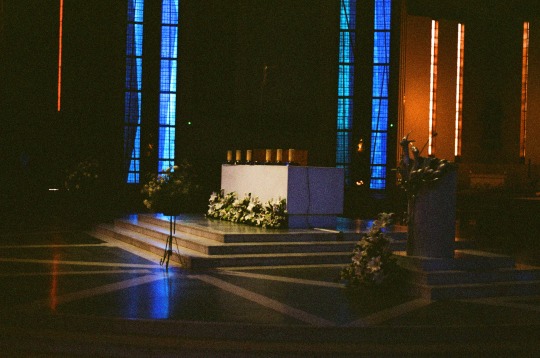
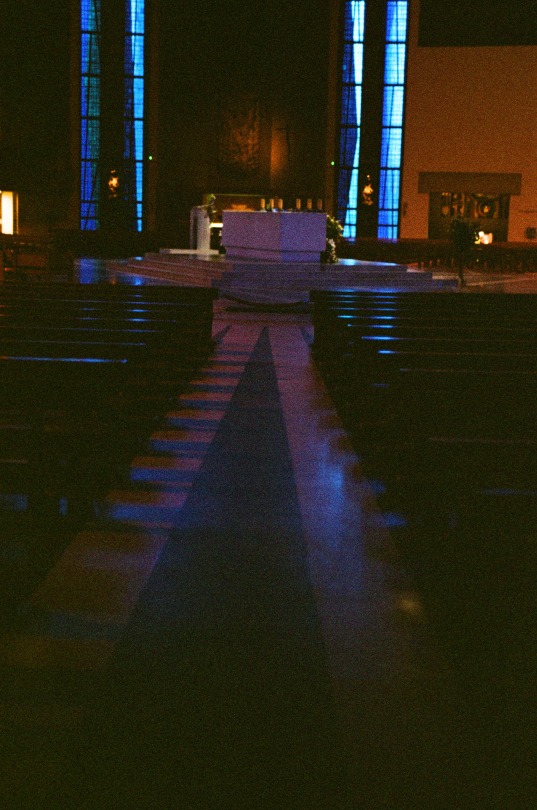


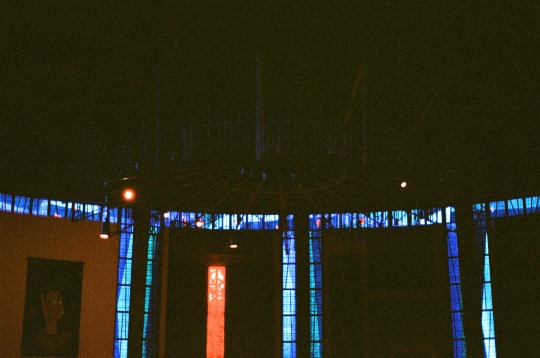


#liverpool#liverpoollomo#lomo#lomography#analogue photography#nikon f65#film slr#nikon slr#35mm colour film#pushing film#exposure compensation#200 shoot at 800#expired film#catholic cathedral#liverpool metropolitan cathedral#Metropolitan Cathedral of Christ the King#low light photography#place of worship#cathedral#film is not dead#don't think just shoot
3 notes
·
View notes
Text
Two wonderful Cathedral's in Liverpool
I was very pleased to visit Liverpool on Friday and to visit the two Cathedral’s which I have visited in the past a number of times but it was lovely to see them again.
The Anglican and Catholic Cathedrals are relatively close together in the centre of Liverpool City
The Anglican Cathedral is the largest in Britain and the volunteer guides made me very welcome. Their website
Liverpool…
0 notes
Text
Mtskheta, Jvari Monastery, Svetistkhoveli Church Georgia
Mtskheta Orthodox Church
The daytrip to Mtskheta, Jvari Monastery, and Svetistkhoveli Cathedral was very educational. The historical area in central-eastern Georgia is wrapped in a peaceful environment of lush greenery and expansive mountain vistas. The stunning area is located about 12 miles north of Tbilisi at the confluence of the Mtkvari and Aragvi Rivers. Mtskheta is home to UNESCO World…

View On WordPress
#"Mtskheta Ancient Capital of Kartli East Georgian Kingdom 3rd Century BC to 5th Century AD#Aragvi River#Asomtavruli Script#Catholicos Patriarch Melkisedec#Caucasus Region#Christ&039;s Robe Svetistkhoveli Cathedral#Gates of the Katholikos Melchizedek#Georgian Christianity#Georgian Hagiography#Georgian Kingdom of Kartli#Georgian Orthodox and Apostolic Church#Golgotha#Great Silk Road#Holy Cross Monastery of Jvari#Javari Church of the Holy Cross#Jvari Monastery#Medieval Georgia#Mirian III First Christian King of Georgia#Mtkvari River#Mtskheta#Mtskheta Jew Elioz#Mtskheta Old Capital City of Georgia#Samtavro Monastery#St. Nino#Stepanoz I King of Iberia#Svetistkhoveli Cathedral#Svetitskhoveli Cathedral#Tetraconch#UNESCO World Heritage Sites
0 notes
Text



RC Metropolitan Cathedral of Christ the King, Liverpool.
#metropolitan cathedral of christ the king#metropolitan cathedral#roman catholic cathedral#cathedral#architecture#liverpool
1 note
·
View note
Text
19th October
St Frideswide’s Day

Source: cornwalllive.com
Today is St Frideswide’s Day. Frideswide was another early English saint who, despite being chaste and energetically pursued by a lustful King AElfgar of Mercia, took pity on her unwanted suitor when the king later lost his sight as a divine punishment. Frideswide prayed to St Margaret for AElfgar’s sight to be restored, which it duly was. Frideswide’s grave and shrine can be seen at Christ Church Cathedral in Oxford.
On this day in 1645, a wedding party was being ferried across Lake Windermere in Cumbria from the Nab to the Ferry Inn. The boat capsized and everyone drowned after which ghostly cries for help could be heard regularly across the Nab. Although the ferrymen eventually started ignoring the calls, they became so loud and insistent that an exorcism was performed that forbade the ghosts from ever again calling out in distress until ‘men can walk over Windermere without wetting their socks; until horses can walk through stone walls; and for as long as ivy remains green.’ The spectral voices have remained silent ever since.
0 notes
Photo

The North Rose window of Chartres Cathedral, France, 1190-1220 CE. The stained glass window shows scenes of Jesus Christ, the prophets and 12 kings of Judah.
413 notes
·
View notes
Text
Spell Ingredients in Traditional Witchcraft
As one would imagine, some of this is now illegal, considered barbaric, or relegated to myth. But others remain. For example, blood magic has stayed.
Human or Animal Fluids and Body Parts
Your blood proves your devotion and serves as your signature. Your target’s blood allows you to manipulate them. Similarly, your saliva, when consumed by another person or an animal, gives you considerable power over them.
Animal entrails are consulted for divination. Their organs are often used in healing balms and all sorts of potions. In curses, the animal that represents a person can serve as a living poppet.
Fruits, Herbs and Other Foodstuff
Then and now, these are staple ingredients. Leaves and eggs are used for divination. Plants, tree barks, grass, crops, and fruits are used in healing ointments, sleeping draughts, teas that induce miscarriage, and worn and edible amulets.
Perhaps lesser known is the use of poisonous mushrooms, flowers and seeds. Simply by being cooked or brewed, they can kill a target from a distance – if fed to an animal, that distance can extend beyond continents.
Religious and National Relics
This list includes the more generic garments of saints, crowns of kings and queens, and armors of warriors, as well as the very specific Holy Grail, Blood of Christ and the True Cross (fragments of the wood from the cross Jesus supposedly died on).
These relics are believed to hold immense power that can be harnessed to heal untreatable illnesses, grab or maintain power, increase beauty and wisdom, raise the dead, and attain immortality. As can be expected, rituals that require them are rarely executed, as these items are rather unusual.
Objects Obtained During a Quest
A common wildflower taken from the top of a specific mountain… A normal fish taken from a particular river… Your typical holy water taken from a faraway cathedral… Ordinary items made extraordinary through the method by which they were obtained.
The logic behind it is that the spellcaster proved the strength of his or her intentions, by overcoming any challenge that came with securing them. Such ingredients are incredibly potent.
Yes, traditional witchcraft can sound weird in this time and age. Click here to find out why.
#Traditional spells#Traditional witchcraft#Witchcraft#Witch tips#servantofthefates#Witchblr#Spells#All About Spells
174 notes
·
View notes
Text

The North Rose window of Chartres Cathedral, France, 1190-1220 CE. The stained glass window shows scenes of Jesus Christ, the prophets and 12 kings of Judah.
77 notes
·
View notes
Text
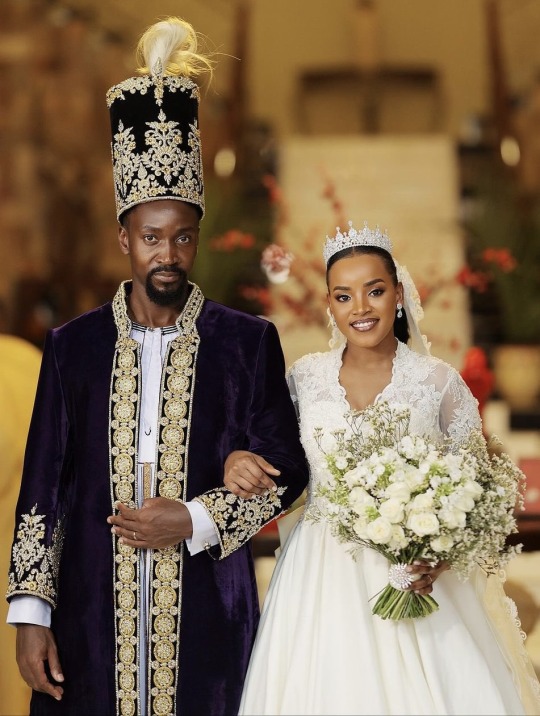
TIARA ALERT: Queen (Inhebantu) Jovia Mutesi of Busoga wore a diamond tiara for her wedding to King (Kyabazinga) William Gabula Nadiope IV of Busoga at Christ Cathedral Bugembe in Jinja City, Uganda on 18 November 2023.
#Tiara Alert#Queen Jovia Mutesi#Busoga#Busogan Royal Family#Uganda#Ugandan Royalty#African Royalty#tiara#diadem#royal jewels#royaltyedit
237 notes
·
View notes
Text

Metropolitan Cathedral of Christ the King Liverpool
47 notes
·
View notes
Text

Live broadcast of ‘Le Sacre de Napoléon V’ on the national channel Francesim 2, hosted by Stéphane Bernard

(Stéphane Bernard) The Emperor will become a quasi-sacred figure through the anointing: it is a sort of transfiguration. The imperial canopy conceals this profoundly sacred moment because the rite must remain a mystery to the common mortals. We are witnessing a revival of the triple blessing from the Reims ceremonial of the kings of Francesim. Their Majesties, kneeling before the altar, receive the triple anointing from the Pope: one on the forehead, the others on both hands. First the Emperor, then the Empress.
In his prayer, the Pope asks God to bestow the treasures and graces of His blessings upon the Emperor. He prays that the Emperor will govern with strength, justice, loyalty, foresight, courage, and perseverance. The Emperor must combat Evil and defend the holy Christian Church. The Empress, for her part, receives God's support, and that of Christ, to preserve the Empire and the French people for eternity.

(Stéphane Bernard) Such a ceremonial highlights the spiritual and mystical dimension of the imperial monarchy. It is a moment steeped in tradition, where every gesture, every word, carries deep symbolism, reminding us of the sacred bonds that unite the sovereign to his people and to God.
(Mgr. Morlot) Almighty and eternal God, who have decreed that, following the example of David, Solomon, and Joash, the foreheads of Kings and Emperors should be adorned with a diadem, so that, through the brilliance of their gemstones and the splendor of their ornaments, they might serve as a vivid and striking image of the majesty that surrounds you to the peoples while they reign on earth���

(Mgr. Morlot) … Pour out, we beseech you, your blessing upon these crowns, so that your servant Napoleon and his spouse, who will wear them on earth, may shine with the radiance of all virtues.


(Pope) May God encircle your brow with the crown of glory and justice...

(Pope) ... May He arm you with strength and courage so that, blessed by Heaven through our hands, filled with faith and good works, you may reach the crown of the eternal kingdom…


(Pope) ... By the grace of Him whose reign and empire extend throughout all ages and ages. Amen.


(Napoléon V) Amen.




⚜ Le Sacre de Napoléon V | N°11 | Francesim, Paris, 28 Thermidor An 230
While the bells ring out and the cannons roar, the Emperor and Empress of Francesim are crowned at Notre-Dame Cathedral in Paris. It was broadcast live on television by Stéphane Bernard, the famous journalist for the crowned heads in Francesim.
Beginning ▬ Previous ▬ Next
⚜ Traduction française
(Stéphane Bernard) L'Empereur va devenir un personnage quasi-sacré grâce à l'onction : c'est une sorte de transfiguration. Le dais impérial cache ce moment tout à fait sacré car le rite doit rester un mystère pour le commun des mortels. Nous assistons à une reprise de la triple bénédiction du cérémonial de Reims des rois de Francesim. Leurs Majestés, agenouillées devant l'autel, reçoivent du Pape la triple onction : une sur le front, les autres sur les deux mains. D'abord l'Empereur, puis l'Impératrice.
Dans son oraison, le Pape demande à Dieu de répandre les trésors et les grâces de Ses bénédictions sur l'Empereur. Il prie pour qu'il gouverne avec force, justice, fidélité, prévoyance, courage et persévérance. L'Empereur doit combattre le Mal et défendre la sainte Église chrétienne. L'Impératrice, quant à elle, reçoit le soutien de Dieu et du Christ, afin de conserver l'Empire et le peuple français dans l'éternité.
Un tel cérémonial met en lumière la dimension spirituelle et mystique de la monarchie impériale. C'est un moment empreint de tradition, où chaque geste, chaque parole, porte un symbolisme profond, rappelant les liens sacrés qui unissent le souverain à son peuple, et à Dieu.
(Monseigneur Morlot) Dieu tout-puissant et éternel, qui avez voulu qu'à l'exemple de David, de Salomon et de Joas, le front des Rois et des Empereurs fût ceint du diadème, afin que, par l'éclat des pierreries et la splendeur de leurs ornements, ils fussent aux des peuples, pendant qu'ils règnent sur la terre, la vive et frappante image de la majesté qui vous environnement...
(Monseigneur Morlot) ... Répandez, nous vous en conjurons, votre bénédiction sur ces couronnes, afin que votre serviteur Napoléon et son épouse, qui les porteront sur la terre brillent de l'éclat de toutes les vertus.
(Pape) Que Dieu ceigne votre front de la couronne de la gloire et de justice ; qu'il vous arme de force et de courage, afin que, bénis du Ciel par nos mains, pleins de foi et de bonnes oeuvres, vous arriviez à la couronne du règne éternel...
(Pape) Par la grâce de celui dont le règne et l'empire s'étendent dans tous les siècles et les siècles. Amen.
(Napoléon V) Amen.
#simparte#ts4#ts4 royal#royal simblr#sims 4 royal#sim : louis#sims 4 fr#sims 4#ts4 royalty#sims 4 royalty#sim : pope#sim : pope gregorius#sim : charlotte#sim : stephane bernard#episode iii#le cabinet noir#coronation napoleon v#ts4 coronation#sim : hortense#sim : marie joséphine#sim : henri#sim : amelie#sim : marianne#sim : sophie#invalides#notre dame de paris#royal sims#ts4 royal family#ts4 royal simblr
47 notes
·
View notes
Text
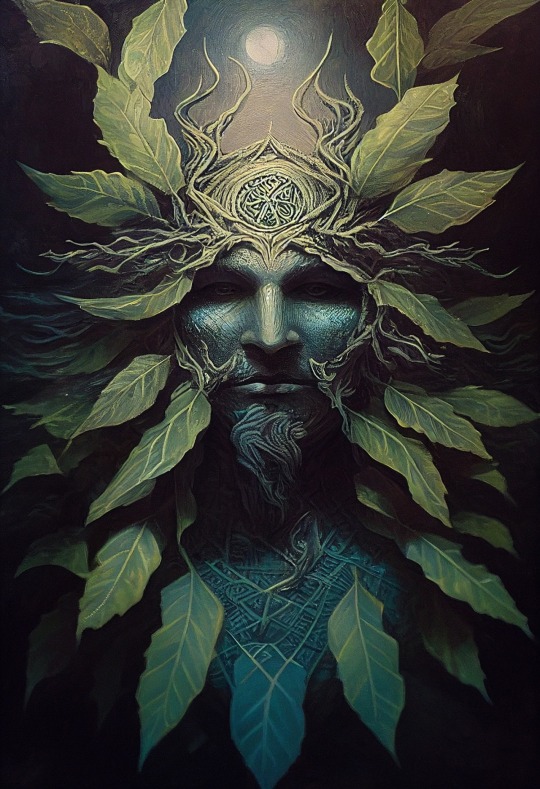
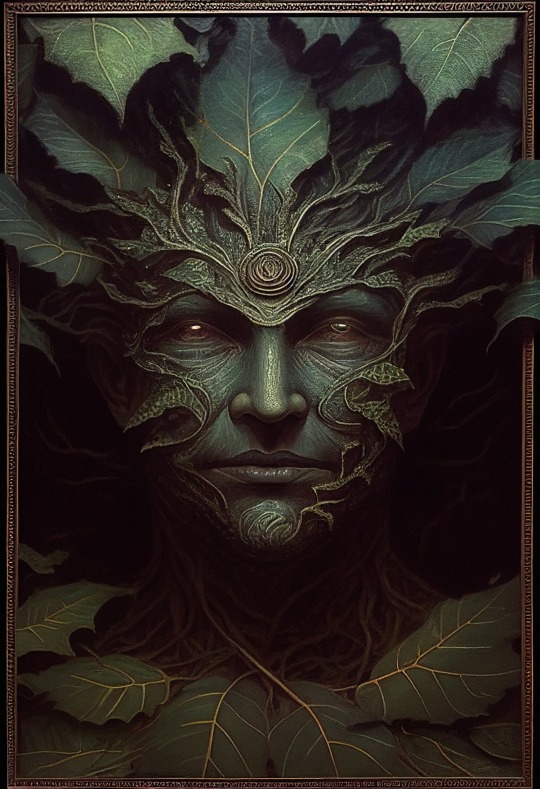
The Green Man
by Talon Abraxas
Symbol of life and nature:
The most common and perhaps obvious interpretation of the Green Man is that of a pagan nature spirit, a symbol of man’s reliance on and union with nature, a symbol of the underlying life-force, and of the renewed cycle of growth each spring. In this respect, it seems likely that he has evolved from older nature deities such as the Celtic Cernunnos and the Greek Pan and Dionysus.
Some have gone so far as to make the argument that the Green Man represents a male counterpart - or son or lover or guardian - to Gaia (or the Earth Mother, or Great Goddess), a figure which has appeared throughout history in almost all cultures. In the 16th Century Cathedral at St-Bertrand de Comminges in southern France, there is even an example of a representation of a winged Earth Mother apparently giving birth to a smiling Green Man.
Because by far the most common occurrences of the Green Man are stone and wood carvings in churches, chapels, abbeys and cathedrals in Europe (particularly in Britain and France), some have seen this as evidence of the vitality of pre-Christian traditions surviving alongside, and even within, the dominant Christian mainstream. Much has been made of the boldness with which the Green Man was exhibited in early Christian churches, often appearing over main doorways, and surprisingly often in close proximity to representations of the Christ figure.
Incorporating a Green Man into the design of a medieval church or cathedral may therefore be seen as a kind of small act of faith on the part of the carver that life and fresh crops will return to the soil each spring and that the harvest will be plentiful. Pre-Christian pagan traditions and superstitions, particularly those related to nature and trees, were still a significant influence in early medieval times, as exemplified by the planting of yew trees (a prominent pagan symbol) in churchyards, and the maintenance of ancient “sacred groves” of trees.
Tree worship goes back into the prehistory of many of the cultures that directly influenced the people of Western Europe, not least the Greco-Roman and the Celtic, which is no great surprise when one considers that much of the continent of Europe was covered with vast forests in antiquity. It is perhaps also understandable that there are concentrations of Green Men in the churches of regions where there were large stretches of relict forests in ancient times, such as in Devon and Somerset, Yorkshire and the Midlands in England. The human-like attributes of trees (trunk-body, branches-arms, twigs-fingers, sap-blood), as well as their strength, beauty and longevity, make them an obvious subject for ancient worship. The Green Man can be seen as a continuing symbol of such beliefs, in much the same way as the later May Day pageants of the Early Modern period, many of which were led by the related figure of Jack-in-the-Green.
Symbol of fertility:
Although the Green Man is most often associated with spring, May Day, etc, there are also several examples which exhibit a more autumnal cast to the figure. For example, some Green Men prominently incorporate pairs of acorns into their designs (there is a good example in King's College Chapel, Cambridge), a motif which clearly has no springtime associations. In the same way, hawthorn leaves frequently appear on English Green Men (such as the famous one at Sutton Benger), and they are often accompanied by autumn berries rather than spring flowers. The Green Man in the Chapelle de Bauffremont in Dijon (one of the few to retain its original paint coloration) shows quite clearly its leaves in their autumn colours.
This may have been simple artistic license. However, acorns, partly due to their shape, were also a common medieval fertility symbol, and hawthorn is another tree which was explicitly associated with sexuality, all of which perhaps suggests a stronger link with fertility, as well as with harvest-time.
Symbol of death and rebirth:
The disgorging Green Man, sprouting vegetation from his orifices, may also be seen as a memento mori, or a reminder of the death that await all men, as well as a Pagan representation of resurrection and rebirth, as new life naturally springs out of our human remains. The Greek and Roman god Dionysus/Bacchus, often suggested as an early precursor of the Green Man, was also associated with death and rebirth in his parallel guise as Okeanus.
Several of the ancient Celtic demigods, Bran the Blessed being one of the best known, become prophetic oracles once their heads had been cut off (another variant on the theme of death and resurrection) and, although these figures were not traditionally represented as decorated with leaves, there may be a link between them and the later stand-alone Green Man heads.
There are several examples of self-consciously skull-like Green Men, with vegetation sprouting from eye-sockets, although these are more likely to be found on tombstones than as decoration in churches (good examples can be seen at Shebbear and Black Torrington in Devon, England). Such images might be interpreted as either representing rebirth and resurrection (in that the new life is growing out of death), or they might represent death and corruption (with the leaves growing parasitically through the decaying body).
The Green Man as archetype:
The very fact that images of the Green Man have appeared historically in such disparate and apparently unconnected locations have led some commentators, notably Roweena Pattee Kryder and William Anderson, to suggest that the figure is part of our collective unconscious, and represents a primeval archetype (in Jungian parlance) which is central to our relationship with Nature.
Phyllis Araneo has suggested that the appearance of the Green Man in European and worldwide art is a cyclical phenomenon triggered by times of crisis or significant change. For example, she suggests the proliferation of Green Man imagery after the 11th Century can perhaps be associated with feelings of relief and celebration after the widely predicted apocalypse of the millennium failed to materialize.
In the same way, the modern resurgence may have been triggered by the environmental crisis we are currently living through. In its modern revival, in the wake of James Lovelock’s Gaia Hypothesis and the birth of the modern Green movement, the Green Man can be seen as the archetype of the “conservator”, whose brief is to counsel us to take from the environment only what we need to survive and to conserve the rest, and to remind us of our responsibilities for the stewardship of the natural world. A quote from Mike Harding succinctly summarizes this position: “If anything on this poisoned planet gives us hope of renewal it is this simple foliate head that has been there in one form or another since the beginning.”
-The Enigma of the Green Man - Theories and Interpretations
37 notes
·
View notes
Text
— Faith in the grishaverse.
I’ve always thought that, despite the important role religion plays in the Grishaverse, it isn’t very well explained when it comes to the Ravkans.
There is no central Ravkan deity. People pray to the saints, who are the ones performing miracles, unlike the real-world concept where people ask saints to pray to God on their behalf.
Not all Grisha are saints, but it’s been debated that all saints were actually Grisha. Grisha used to be much more powerful, but their powers diminished after the formation of the Second Army and its orders.
The world was created in The Making at the Heart of the World (let’s call it MHW for short, lol), which is like the central point of creation where everything comes from. The Grisha are connected to MHW—they come from it and return to it after death, but the concept of "Grisha" came later than the Ravkan religion. People credit Sankt Grigori, who was a healer, with forming the first Corporalki, but even in Grigori’s time, saints were already a thing.
The religion is older than Ravka itself. The monks helped the first king of Ravka unify the country, and then founded the Priestguard in exchange for their help. It’s suggested that they were also Grisha.
It’s implied that all gods are the same god, meaning Djel, the saints, and even the Ravkan religion come from the same central source. (I don’t totally agree with this because Ghezen is opposed to Djel, but okay, lol).
Leigh has said the religion is based on Slavic paganism, but the very concept of having saints, cathedrals, icons, monks, and a kind of central religious authority (the Apparat) feels a lot like Eastern Orthodoxy, which was the official religion of the Russian Empire.
In an interview from 2012 (pre-Six of Crows), she said: “I never get specifically into Christianity. That was really important to me. There is no Christ in this world. The religion that is in the world is much closer to the kind of pagan tradition that was in Russia pre-Christianity, and even that grew out of the influence of Christianity, but that couldn’t tamp down these local mythologies.”
Interestingly, a concept of heaven or hell is never mentioned… The Fjerdans are very focused on not sinning against Djel, but we don’t really know what happens if you do. Djel has his saints and is the higher power for the Fjerdans, just like Ghezen is for the Kerch. But there isn’t a central Ravkan deity, and we haven’t heard much about the Shu religion either, just that they believe in some « seven knights », but it was never adressed. I think they believe in more sciency/superstitious and the Suli believes in their Saints, Gods and curses…
Grisha, on the other hand, don’t believe in life after death, though it’s unclear if non-Grisha do. In Crooked Kingdom, Inej tells Nina to let Matthias go to his god, which might imply some kind of afterlife for the Fjerdans. At the end of Rule of Wolves, it’s hinted that all gods are the same god (AGAIN I’d disagree—don’t tell me Ghezen and Djel are the same), suggesting Djel could be the central god of the Grishaverse, taking different forms depending on the culture.
The use of expressions like “heaven” and “hell” might just be a way of speaking that’s familiar to us in the real world. Sometimes authors reshape these concepts to fit their fictional worlds, but Leigh Bardugo doesn’t seem to have done that here.
Honestly, we don’t know much. We know more about the Grisha’s involvement in religion and how people interact with it than we do about the beliefs themselves… What do they believe in? Is there a code of behavior/practice? Is MHW like the Big Bang, or was it set in motion by someone else? I have questions, too…
I had another point, but I forgot it before I could type it out—I'll add it in the comments if I remember… The Nikolai Duology touches on this more, but it doesn’t explain a lot either. It’s more about the influence of religion on Ravkan/Grisha society than actual world-building.
#grishaverse#six of crows#shadow and bone netflix#shadow and bone#grisha#the darkling#the starless saint#s&b#soc#ketterdam#ravka#religion studies#sun summoner
27 notes
·
View notes